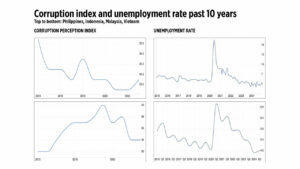Last Tuesday, Feb. 4, the Counsel of Government-owned and -controlled corporations (GOCCs), Solomon M. Hermosura, went to the Supreme Court to defend the transfer by the Philippine Health Insurance Corp. (PhilHealth) of excess funds to the National Treasury — saying that it was lawful and that it does not impair the constitutional right to health, and thus petitions against it should be dismissed by the Court.
It is lawful, he said, because it complies with the Department of Finance (DoF) Circular 003-2024. It affirms the Filipinos’ right to health because in 2024, PhilHealth increased the all-case rates package by at least 95%, and enhanced outpatient packages for chronic conditions with greater coverage for critical and life-saving treatments.
Despite remitting P60 billion in excess funds last year, Mr. Hermosura pointed that PhilHealth’s operating budget for 2025 has been increased to P284 billion — P25 billion more than its 2024 budget, and P118 billion more than its 2022 budget of P166 billion.
Good arguments, Mr. Hermosura. And a good initiative, Finance Secretary Ralph G. Recto. I have argued before and I will argue again that between health parochialism (and education or social work parochialism, etc.) and fiscal realism, the latter should prevail.
Health and social welfare spending by both national and local governments jumped a great deal from 2020-2024, even if the virus scare has simmered starting February 2022 when the election campaign period started.
The budget deficit averaged P1.54 trillion/year in 2020-2023, from only P0.52 trillion/year in 2017-2019. Financing or borrowings averaged P2.20 trillion/year in 2020-2023, from only P0.81 trillion/year in 2017-2019.
But in 2024, some fiscal “mini-miracles” happened.
One, non-tax revenues jumped from an average of P333 billion/year in 2020 to 2023, to P555.3 billion from January-November 2024 alone. This was mainly because Mr. Recto increased the mandatory remittances of GOCCs from 50% to 75%.
Two, financing or borrowing decreased from P2.2 trillion/year in the last four years to only P1.24 trillion in January-November 2024. This was mainly because the DoF avoided new borrowings to finance certain expenditures by tapping the excess funds of PhilHealth and the Philippine Deposit Insurance Corp. or PDIC.
Again, I support the DoF and the rest of economic team, and the GOCCs Counsel for arguing the legal and fiscal rationality of transferring the excess funds of PhilHealth and PDIC to the National Government.
Government should cut not only borrowings but also expenditures. Many subsidies must be cut and discontinued, people should go back being self-reliant and not dependent on the state for their household needs. In exchange, the state should cut income tax and other taxes to allow the people to keep more of their money and savings for themselves and their households.
OGP MEETINGThe Open Government Partnership (OGP) Asia and Pacific Regional Meeting Philippines 2025 kicked off this week, Feb. 3 to 7, with events mostly held at UP Bonifacio Global City (BGC) and the Grand Hyatt Manila in BGC. Among the many topics discussed were transparency in public procurement, digital governance, anti-corruption and public integrity.
I attended the panel on “Leveraging strategic collaborations to address corruption” yesterday, Feb. 5, at the Grand Hyatt. It was sponsored by Stratbase and Democracy Watch and the keynote speaker was Budget Secretary Amenah F. Pangandaman.
Corruption is a perennial issue in practically all governments around the world, from multilateral agencies to national down to local governments. I checked Transparency International’s corruption index, and limited my comparison to four ASEAN countries. I then compared their index scores with their employment data to test the hypothesis that “high corruption is equal to low job creation and high unemployment.”
The Philippines has been declining on the corruption perception index over the last 10 years, and its unemployment rate was also declining (except during 2020-2021 lockdown dictatorship). Indonesia exhibits the same pattern.
Malaysia has had wild fluctuation in the corruption index while its unemployment rate has been falling back to pre-lockdown levels. Vietnam has a weird situation: it is rising on the corruption index yet has declining unemployment (see the accompanying chart).
So, open government is good and should ultimately lead to more transparency and less corruption. But it will take time because the corrupt personnel and officials will always find ways to cover up their acts.
To effectively cut down on corruption, we should move towards cutting down the size of government, and cutting the government’s spending, bureaucracies, and subsidies. And we should cut the taxes and borrowings needed to sustain big government.
In December 2023, Argentina’s President Javier Milei’s first month in office, he cut the number of government ministries or departments from 19 to nine and quickly achieved a budget surplus after two months, and slowly stabilized prices. There was no civil war as predicted by the anti-deregulation lobbyists and activists.
US President Donald Trump and Department of Government Efficiency (DOGE) czar Elon Musk are also doing a similar quick and big cuts in federal agencies, bureaucracies, and expenditures. Milei’s pace of deregulation and his results have inspired Trump and Musk to do their own deregulation and spending cuts, borrowing cuts, and, very soon, another tax cut.
Bienvenido S. Oplas, Jr. is the president of Bienvenido S. Oplas, Jr. Research Consultancy Services, and Minimal Government Thinkers. He is an international fellow of the Tholos Foundation.
minimalgovernment@gmail.com

